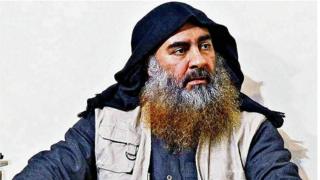 Image copyright
US Department of Defense/Reuters
Image copyright
US Department of Defense/Reuters
The Islamic State (IS) group has confirmed the death of its leader, Abu Bakr al-Baghdadi, and named his successor.
An IS outlet on messaging service Telegram announced that Abu Ibrahim al-Hashemi al-Qurashi was the group's new leader and "caliph".
US special forces tracked down Baghdadi in north-west Syria at the weekend and attacked his compound.
The IS leader fled into a tunnel and killed himself with a suicide vest.
Baghdadi was declared leader of the extremist group in 2014 when IS took control of huge swathes of Iraq and Syria and imposed its rule over the civilian population.
In an audio message, IS also confirmed the death of spokesman Abu al-Hasan al-Muhajir - who was killed in a separate joint US-Kurdish operation on 27 October. The Saudi national had been considered a potential successor to Baghdadi.
New IS spokesman Abu Hamza al-Qurashi also called on Muslims to swear allegiance to Abu Ibrahim al-Hashemi.
Hashemi's name is not known to global security forces, and is believed to be a nom de guerre.
IS did not release any details about the new leader or release a photo, but they did claim he was a veteran jihadist fighter who had fought against the West.
The group also made clear that he claims to be descended from the Prophet Muhammad's Quraysh tribe - something generally held by pre-modern Sunni scholars as being a key qualification for becoming a caliph.
Before the announcement, the BBC's Mina al-Lami said: "If IS chooses to appoint someone who is not a Qurashi, then perhaps it is an implicit acknowledgement that the 'caliphate' is no more."

Media playback is unsupported on your device
Meanwhile, the US has released its first images of the raid that targeted Baghdadi.
The head of US Central Command, Gen Kenneth McKenzie, said the destroyed buildings were left looking like "a parking lot with large potholes".
